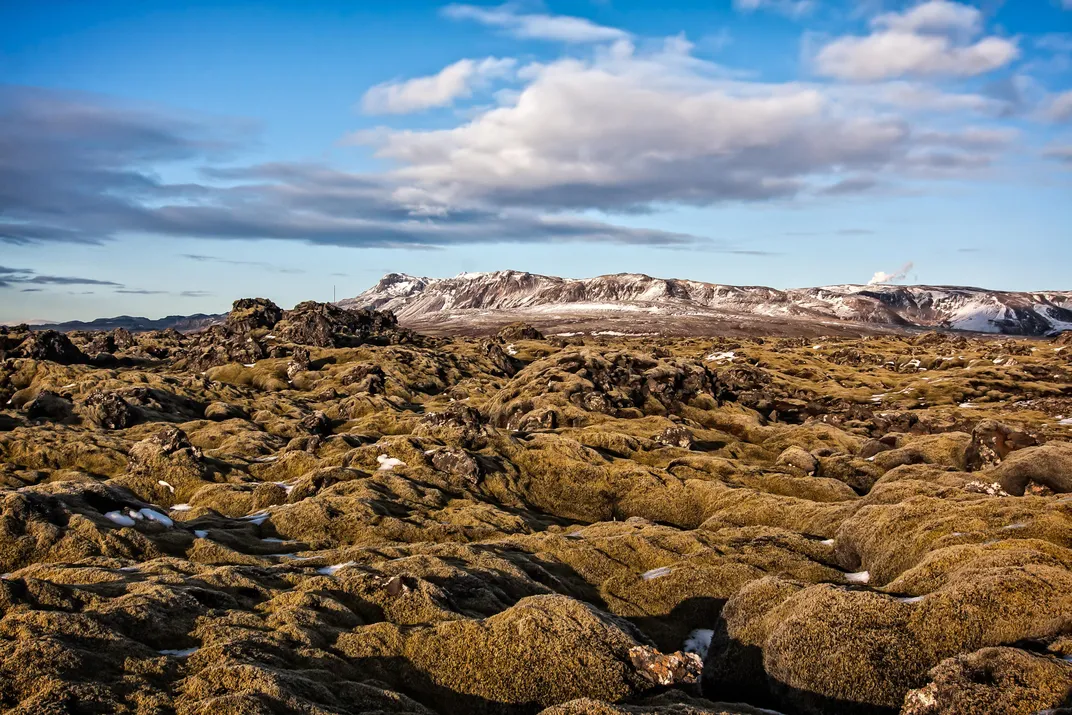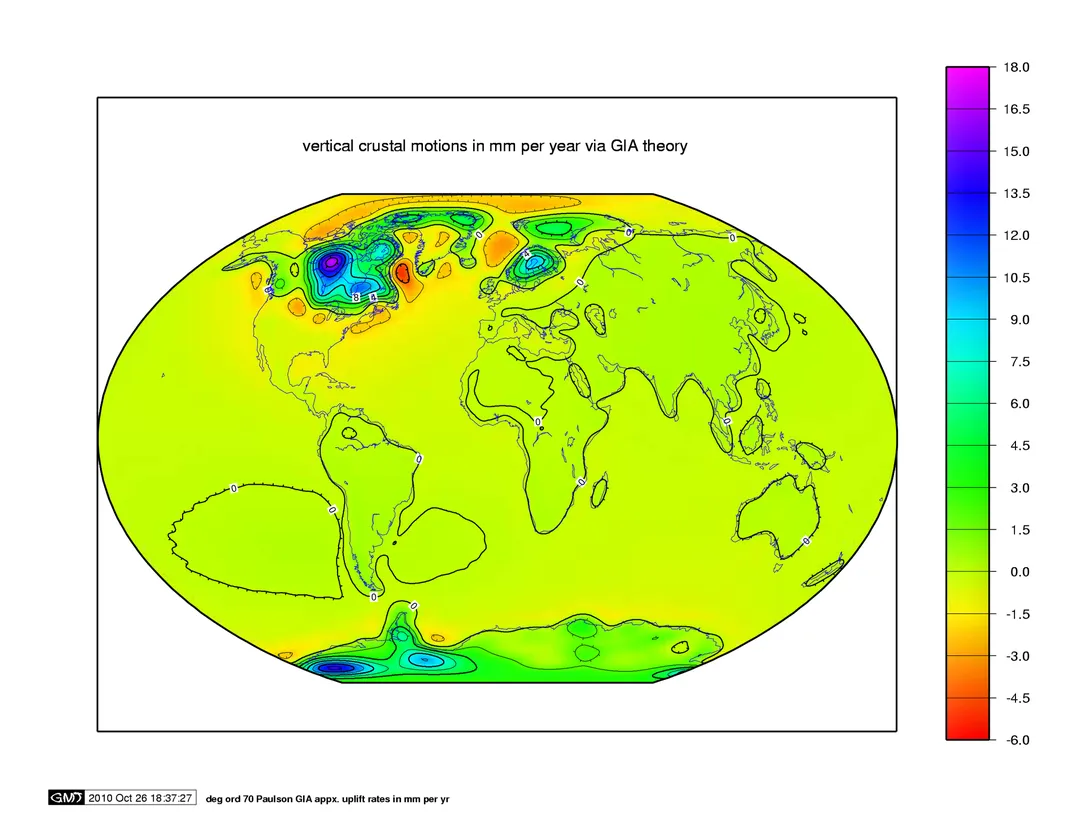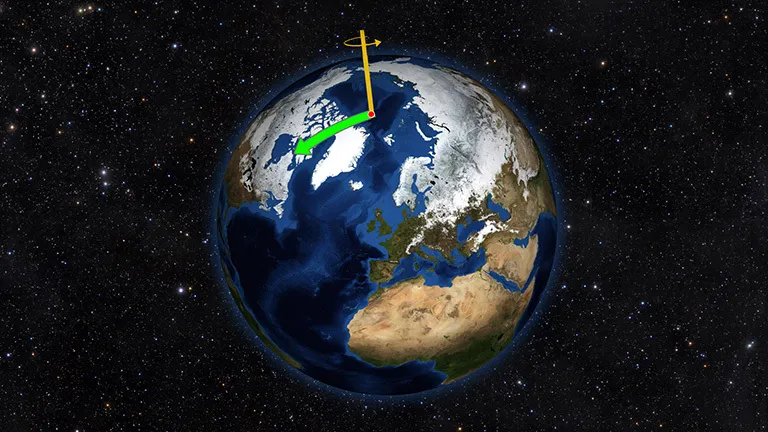Melting Glaciers Are Wreaking Havoc on Earth’s Crust
Sea levels are dropping, earthquakes and volcanoes are waking up, and even the earth’s axis is moving—all because of melting ice
/https://tf-cmsv2-smithsonianmag-media.s3.amazonaws.com/filer/87/d8/87d8afd9-fda2-4b45-a485-95e2e8a0e185/alaska-flickr_umnak-by-sa.jpg)
You've no doubt by now been inundated with the threat of global sea level rise. At the current estimated rate of one-tenth of an inch each year, sea level rise could cause large swaths of cities like New York, Galveston and Norfolk to disappear underwater in the next 20 years. But a new study out in the Journal of Geophysical Research shows that in places like Juneau, Alaska, the opposite is happening: sea levels are dropping about half an inch every year.
How could this be? The answer lies in a phenomenon of melting glaciers and seesawing weight across the earth called “glacial isostatic adjustment.” You may not know it, but the Last Ice Age is still quietly transforming the Earth’s surface and affecting everything from the length of our days to the topography of our countries.
During the glacier heyday 19,000 years ago, known as the Last Glacial Maximum, the Earth groaned under the weight of heavy ice sheets thousands of feet thick, with names that defy pronunciation: the Laurentide Ice Sheet, the Cordilleran Ice Sheet, the Fennoscandian Ice Sheet, and many more. These enormous hunks of frozen water pressed down on the Earth’s surface, displacing crustal rock and causing malleable mantle substance underneath to deform and flow out, changing the Earth’s shape—the same way your bottom makes a depression on a couch if you sit on it long enough. Some estimates suggest that an ice sheet about half a mile thick could cause a depression 900 feet deep—about the of an 83-story building.
The displaced mantle flows into areas surrounding the ice sheet, causing that land to rise up, the way stuffing inside a couch will bunch up around your weight. These areas, called “forebulges,” can be quite small, but can also reach more than 300 feet high. The Laurentide Ice Sheet, which weighed down most of Canada and the northern United States, for example, caused an uplift in the central to southern parts of the U.S. Elsewhere, ancient glaciers created forebulges around the Amazon delta area that are still visible today even though the ice melted long ago.
As prehistoric ice sheets began to melt around 11,700 years ago, however, all this changed. The surface began to spring back, allowing more space for the mantle to flow back in. That caused land that had previously been weighed down, like Glacier Bay Park in Alaska and the Hudson Bay in Canada, to rise up. The most dramatic examples of uplift are found in places like Russia, Iceland and Scandinavia, where the largest ice sheets existed. In Sweden, for example, scientists have found that the rising land severed an ancient lake called Malaren from the sea, turning it into a freshwater lake.
At the same time, places that were once forebulges are now sinking, since they are no longer being pushed up by nearby ice sheets. For example, as Scotland rebounds, England sinks approximately seven-tenths of an inch into the North Sea each year. Similarly, as Canada rebounds about four inches each decade, the eastern coast of the U.S. sinks at a rate of approximately three-tenths of an inch each year—more than half the rate of current global sea level rise. A study published in 2015 predicted that Washington, D.C. would drop by six or more inches in the next century due to forebulge collapse, which might put the nation’s monuments and military installations at risk.

Recent estimates suggest that land in southeast Alaska is rising at a rate of 1.18 inches per year, a rate much faster than previously suspected. Residents already feel the dramatic impacts of this change. On the positive side, some families living on the coast have doubled or tripled their real estate: As coastal glaciers retreat and land once covered by ice undergoes isostatic rebound, lowland areas rise and create "new" land, which can be an unexpected boon for families living along the coast. One family was able to build a nine-hole golf course on land that has only recently popped out of the sea, a New York Times article reported in 2009. Scientists have also tracked the gravitational pull on Russell Island, Alaska, and discovered that it’s been weakening every year as the land moves farther from the Earth’s center.
Uplift will increase the amount of rocky sediment in areas previously covered in water. For example, researchers predict that uplift will cause estuaries in the Alaskan town of Hoonah to dry up, which will increase the amount of red algae in the area, which in turn, could damage the fragile ecosystems there. In addition, some researchers worry that the rapid uplift in Alaska will also change the food ecosystem and livelihood for salmon fishers.
At the same time, there are a lot of new salmon streams opening up in Glacier Bay, says Eran Hood, professor of environmental science at the University of Alaska. “As glaciers are melting and receding, the land cover is changing rapidly,” he says. “A lot of new areas becoming forested. As the ice recedes, salmon is recolonizing. It’s not good or bad, just different.”

Although not as visible, all the changes caused by glacier melt and shifting mantle is also causing dramatic changes to the Earth’s rotation and substances below the earth’s surface.
As our gargantuan glaciers melted, the continents up north lost weight quickly, causing a rapid redistribution of weight. Recent research from NASA scientists show that this causes a phenomenon called “true polar wander” where the lopsided distribution of weight on the Earth causes the planet to tilt on its axis until it finds its balance. Our north and south poles are moving towards the landmasses that are shrinking the fastest as the Earth’s center of rotation shifts. Previously, the North Pole was drifting towards Canada; but since 2000, it’s been drifting towards the U.K. and Europe at about four inches per year. Scientists haven’t had to change the actual geographic location of the North Pole yet, but that could change in a few decades.
Redistribution of mass is also slowing down the Earth’s rotation. In 2015, Harvard geophysicist Jerry Mitrovica published a study in Science Advances showing that glacial melt was causing ocean mass to pool around the Earth’s center, slowing down the Earth’s rotation. He likened the phenomenon to a spinning figure skater extending their arms to slow themselves down.
Glacial melt may also be re-awakening dormant earthquakes and volcanoes. Large glaciers suppressed earthquakes, but according to a study published in 2008 in the journal Earth and Planetary Science Letters, as the Earth rebounds, the downward pressure on the plates is released and shaky pre-existing faults could reactivate. In Southeast Alaska, where uplift is most prevalent, the Pacific plate slides under the North American plate, causing a lot of strain. Researchers say that glaciers had previously quelled that strain, but the rebound is allowing those plates to grind up against each other again. “The burden of the glaciers was keeping smaller earthquakes from releasing tectonic stress,” says Erik Ivins, a geophysicist at NASA’s Jet Propulsion Laboratory.
Melting glaciers may also make way for earthquakes in the middle of plates. One example of that phenomenon is the series of New Madrid earthquakes that rocked the Midwestern United States in the 1800s. While many earthquakes occur on fault lines where two separate plates slide on top of each other, scientists speculate that the earthquakes in the New Madrid area occurred at a place where hot, molten rock underneath the Earth’s crust once wanted to burst through, but was quelled by the weight of massive ice sheets. Now that the ice sheets have melted, however, the mantle is free to bubble up once again.
Scientists have also found a link between deglaciation and outflows of magma from the Earth, although they’re not sure why one causes the other. In the past five years, Iceland has suffered three major volcanic eruptions, which is unusual for the area. Some studies suggest that the weight of the glaciers suppressed volcanic activity and the recent melting is 20-30 times more likely to trigger volcanic eruptions in places like Iceland and Greenland.

Much of the mystery pertaining to ancient glaciers is still unsolved. Scientists are still trying to create an accurate model of glacial isostatic adjustment, says Richard Snay, the lead author of the most recent study in the Journal of Geophysical Research. “There’s been such software since the early '90s for longitude and latitude measurements but vertical measurements have always been difficult,” says Snay. He and colleagues have developed new equations for measuring isostatic adjustment based off of a complex set of models first published by Dick Peltier, a professor at the University of Toronto. Peltier’s models don’t only take into account mantle viscosity, but also past sea level histories, data from satellites currently orbiting the Earth and even ancient records translated from Babylonian and Chinese texts. “We’re trying to look at glaciation history as a function of time and elasticity of the deep earth,” says Peltier. “The theory continues to be refined. One of the main challenges of this work is describing the effects that are occurring in the earth’s system today, that are occurring as a result of the last Ice Age thousands of years ago.”
Added on to all the unknowns, researchers also don’t know exactly how this prehistoric process will be affected by current patterns of global warming, which is accelerating glacial melt at an unprecedented rate. In Alaska, global warming means less snow in the wintertime, says Hood.
“There is a much more rapid rate of ice loss here compared to many regions of the world,” he says. “The human fingerprint of global warming is just exacerbating issues and increasing the rate of glacial isostatic adjustment.”
And while the effects may vary from city to city—local sea levels may be rising or dropping—it’s clear that the effects are dramatic, wherever they may be. Although many of glaciers have long gone, it’s clear that the weight of their presence still lingers on the Earth, and on our lives.